Text
Day 3 of aloukik, Women in folklore is ongoing! Can't wait to read your stories
0 notes
Text
Love of a Mother, Wrath of the Goddess!!!
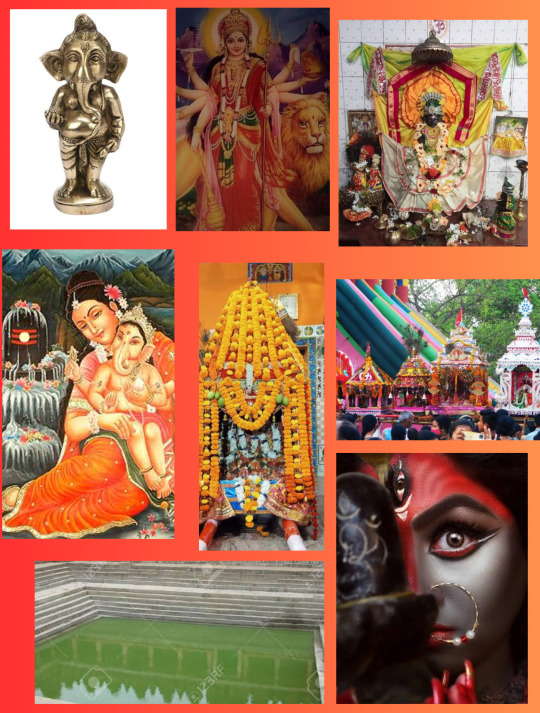
"Hey, Bhagwan, how could I be so late", exclaimed Alka while hurrying down the stairs. Usually, she would have finished her daily puja by now, but today she got up late. She quickened her pace some more and soon reached the door of the mandir. But to her astonishment, she found the door unbolted.
"How could this happen", thought Alka. "I am always the first one to unlock this door."
She pushed the door open and entered the mandir. She started her usual ritual, when she felt something odd. At first, she didn't notice anything wrong, but soon found out the problem.
The brass Bal Ganesh Murti was missing!
Soon, the entire household was informed. But nobody had any idea about the missing idol. After searching all over the house, Alka's Jeje Bapa (grand father), Narendra Panda, finally called the Police. Police came and questioned each and every member of the family. But they still couldn't find anything about the Murti.
Narendra Babu was very worried about the missing Murti and requested the Police to do their utmost to search the same.
"Dola festival is coming next week", he told the Police Officer. "Though the Bal Ganesh Murti is worshipped in our house daily, but during Dola festival, the Bal Ganesh is part of the entourage of the Laxmi-Narayan deity of our village's chief temple. The Bal Ganesh is considered as the son of our Gram Devi Basulei Thakurani (Form of Goddess Durga/Parvati) and nephew to Lord Narayana. Hence, Bal Ganesh accompanies Him when He goes for the procession in the decorated Bimana (swinging palanquin)."
Narendra Babu tried to make the Police understand the significance of finding the Murti soon, by telling them that if Murti wasn't found, it would not only affect their house, but the entire village. "Everyone's sentiments will be hurt", stated the old man with teary eyes.
After dealing with Police and imploring them some more, he went to village head priest, Jagabandhu Panda's house and informed him of the theft. The head priest was equally troubled on hearing the news, but he soon calmed his mind and came up with a plan.
"Don't let the news of the theft out", stated the wise priest. "It might cause tension among the villagers and affects the peace and tranquility of our village. You know, everyone's sentiments is associated with Bal Ganesh."
"It's a good idea, but then what will we tell everyone when they ask about the absence of the Murti in the Bimana", questioned Narendra Babu. "It's all my fault. Bal Ganesh was under my care. I couldn't protect Him. I deserve to be punished with harshest punishment", ranted the guilt-stricken man.
"Don't say like that. It can happen to anyone", the head priest tried to pacify him. "Don't worry, I will think of a way. Let's wait for few days, Police might find the thief and recover the Murti", he advised.
Narendra Babu acted as per his instructions and also instructed his family members to do the same. But after waiting for three to five days, when no news came from Police, he again visited the head priest.
"Jaga Gosei, what are we going to do now? Dola is day after tomorrow and we haven't got the Murti back yet", cried a distraught Narendra Babu.
"I have thought of a solution. I will depart for Puri right now and buy a similar Murti from artisans near the Jagannath Temple. We will place that in the Vimana, along with Laxmi Narayan. Noone will notice anything wrong", informed the head priest.
They formulated a plan and Jaga Gosei departed for Puri without delay to carry out the same.
But unbeknown to Narendra Babu and Jaga Gosei, Goddess Basulei had plans of her own.
That night, Surja, son of a villager Mukunda, suffered from a strange ailment. He was running a fever since last two days. But that night, he would cry out in delirium in one moment and then would laugh at other. He kept mumbling nonsense most of the time. The doctor's medicine couldn't give him any relief. At last, the doctor gave him some sedatives and he fell unconscious.
Sabita, his distressed mother started praying to Goddess Basulei for his son's safety. Amidst her prayer, she witnessed a terrifying vision.
She saw blood tears in the eyes of the idol of Goddess Basulei. When Her eyes fell on Sabita, she looked at her with reproach.
"Do you know, why am I crying tears of blood", questioned the angry Goddess. "Tell me, if your son die today, will you replace him with another?"
"Will you forget his existence and love his lookalike as your son? Answer me."
"No, you won't. Then how could you all expect me to do so?"
"Tell your son to return my Son. If my Son doesn't reach His proper place before Jagabandhu comes back from Puri with a new idol, then I will cut your son into three parts, just like he had done to my Son."
Sabita woke up with a start, only to realise she had fallen asleep while praying. But she knew in her heart, what she saw was not a dream, but a warning from the Goddess herself.
She went near her son and waited till he recover from effects of sedatives. Fortunately, when Surja finally woke up, he was in a lucid state. The first thing he saw on waking up was his mother's scared and teary eyes and the first word, he heard was his mother's question.
"Where did you hide the Bal Ganesh Murti?", asked Sabita directly.
Surja was startled on hearing his mother's question and tried to evade answering the same. But Sabita wouldn't give him any leeway. Finally, after hearing from his mother about the dream, he confessed everything.
He was helping out regarding Dola preparation in Narendra Babu's house when he saw the shiny brass Idol. He was overcame by greed and returned to the house at night and stole the Idol. He knew Police might search the whole village for the Murti. Hence, he unscrewed the Murti, separated it into three parts and hid it inside the pond of nearby Bhawani Shankar temple.
On hearing her son's confession, Sabita was dumbfounded. "How could you? Haven't you heard stories about the Murti being Pratyeksha (divinity is evident)?"
Surja didn't reply to his mother's questions and just started laughing maniacally.
Sabita remembered Goddess's warning and directly went to Police and informed them everything. The Police informed Narendra Babu and searched the temple pond. They found three separated parts of the Murti by that afternoon as Surja mentioned.
Police directly handed the Murti to Narendra Babu, too scared to even take it back to Police Station to write reports.
Narendra Babu took back and placed the Murti at its proper place. When Jaga Gosei came back from Puri that evening with a new idol, he got to know everything from Narendra Babu. He apologized to both Goddess Basulei and Bal Ganesh for his audacious plan of replacing him with a new idol. He kept the new Bal Ganesh Murti at his own home and worshipped it daily.
And Surja, though his mother saved his life, but she coqqq1uldn't save his sanity. He roamed around the village as a lunatic for the rest of his life as an example and proof of a Mother's love and the Goddess's wrath.
P.S.- This is a story from Odisha. It is a fictionalised version of a true event as witnessed by my mother in her village. The priest who went to Puri was my own Aja (maternal grandfather) and the new Ganesh Murti is still worshipped till today in my maternal grandparents' house.
Thank you @thereader-radhika for encouraging me to tell this story. If not for you, I would have never realised stories of divine wrath can be part of horror.
@kathaniii | Aloukik 2023 | Day 2 | Horror
23 notes
·
View notes
Text
Second day of #Aloukik: Horror
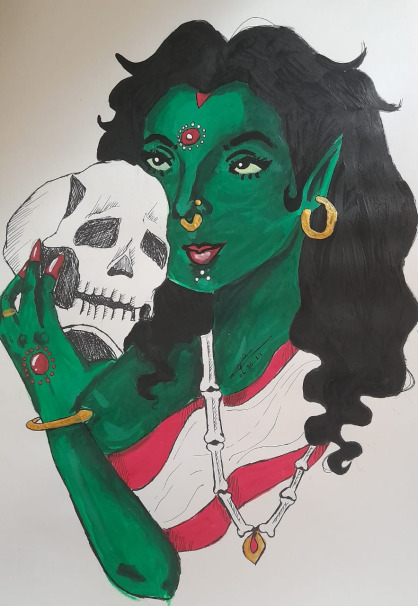
I am from Bengal, where tales of the Shakchunni are rampant. Usually known to be a woman who died before she could experence maritial pleasures, the Shakchunni sits atop trees waiting for women to walk by with their hair open. She then catches them and traps then in the tree and takes their place in their home.
My artwork depicts a newly wed Shakchunni, heavily inspired from the Bengali children’s show; Thakumar Jhulli.
@kathaniii
56 notes
·
View notes
Text
In case you're Assamese or Irish, you will NOT romanticize about fairies, or the faefolk in general. Why?
Pori | পৰী

They are supernatural beings that exist in two distinct genders - male and female. These creatures are believed to reside in bodies of water such as lakes, ponds, and rivers. According to legend, female pori have the ability to possess males while male pori possess females.
The effects of possession by a pori are said to be severe, with the afflicted person often exhibiting erratic, maniacal behavior. It is thought that pori possess humans in order to experience the physical world and satisfy their own desires.
In order to rid oneself of a pori possession, there are specific chants and rituals that can be performed. These chants are believed to have the power to banish the pori from the body, freeing the person from their influence.
The concept of pori and their possession of humans is deeply rooted in folklore and mythology in certain cultures. While these beliefs may not be scientifically verifiable, they continue to hold a significant place in the cultural imagination of those who believe in them.
And in case of Irish mythology, yall know about Changelings and Sidhe already now don't you?
@kathaniii
18 notes
·
View notes
Text
Category:
Ghosts in Bollywood


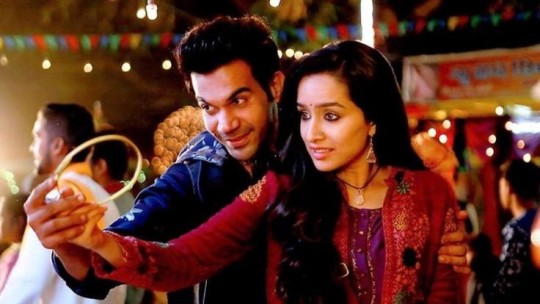

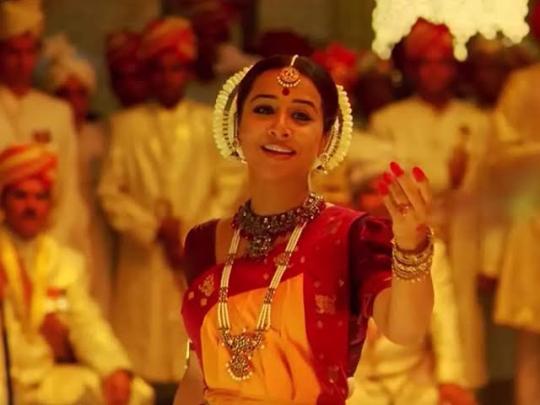

Woh Kaun Thi? (1964)
Om Shanti Om (2007)
Stree (2018)
Bulbbul (2020)
Bhool Bhulaiyaa (2007)
Talaash (2012)
@kathaniii
133 notes
·
View notes
Text
Day 2 of Aloukik event.
Horror
Let's talk about some of the mythical creatures of Assamese folklore, shall we?
Baak | বাঁক

The baak is a creature that appears frequently in folktales across Assam. It is typically found near water bodies and is known to be malevolent, often causing trouble for fishermen and other locals. The baak has a particular fondness for fish and can be dangerous, sometimes even drowning its victims.
According to folklore, the baak has a pouch attached to it that contains its soul. Destroying this pouch is the only way to kill a baak. Additionally, the baak is said to assume the form of its victim after death or possess them, sometimes going on to live with the victim's family and attempting to harm them as well.
To avoid encountering a baak, carrying a torn fishing net is said to be effective, as baaks are believed to be afraid of it. In some stories, the baak assumes the form of a man to live with his wife.
In "Assamese Demonology," Benudhar Rajkhowa classifies Assamese spirits into sub-terrananian, terrestrial, aerial, and celestial categories, placing the baak among the terrestrial spirits. Within this category, the baak is classified as an aqueous spirit and is listed as the first of five major aqueous spirits.
Dót | দ'ত
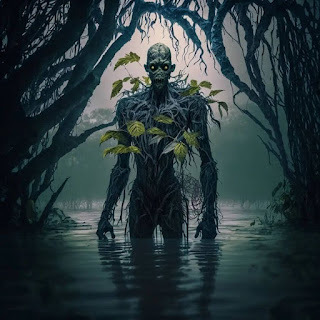
The dót, a spirit derived from the Sanskrit word daitya meaning demon, is well-known among the Assamese people. He lures individuals to secluded areas, where he inflicts severe beatings on them. However, he rarely kills his victims. Sometimes, he takes the form of a friend and convinces his target to accompany him to the watercourse where he has placed his fishing trap, only to leave them to suffer his wrath. The dót is a slender, tall figure with long, spike-like fingers. He resides in water channels, tanks, and overgrown watery plants , remote places. His appearance is jet black and he is naked, except for his prominently exposed fingers. The spirit is covered in a glutinous substance, giving him an advantage in wrestling matches with his victims. Mustard grain is the only thing that terrifies the dót. This is why it plays a crucial role in exorcism ceremonies. The dót initially appears as a regular person, but gradually grows taller until he vanishes entirely. At this point, the victim is so terrified that the spirit can possess them. The dót beats his victim mercilessly when he is alone but refrains from harming them in front of his wife. The spirit is powerless against righteous people. His spectral bag is his talisman, which gives him superhuman powers. If it is snatched from him, the dót loses his abilities and becomes a bound servant to the person who took it. He is forced to work as a regular human being until he can retrieve his bag. Children wear fishing hooks around their necks to scare off the dót.
Unoish-hotiya | ঊনৈশহতীয়া
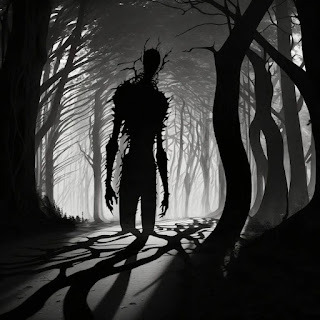
It is a ghost that originates from an earlier time when people used unconventional methods of measurement, such as using their hands and fingers. The name of this ghost is derived from its towering height, which is said to be around 19 hands tall when they are put together. This ghost is typically described as a black shadow that appears during prime afternoon hours. It is believed that if someone happens to walk under the shadow of Unoish-hotiya, they and their family will be plagued with turmoil and misfortune.
Many people in Assam still fear the wrath of Unoish-hotiya and take precautions to avoid walking under its shadow. There are also several stories and legends associated with this ghost that have been passed down from generation to generation. The fear of encountering Unoish-hotiya serves as a warning to people to be cautious and respectful of the unknown. Despite the lack of scientific evidence to support the existence of such supernatural beings, the belief in Unoish-hotiya continues to be deeply ingrained in the cultural consciousness of certain communities.
পিশাচ | Pixaas
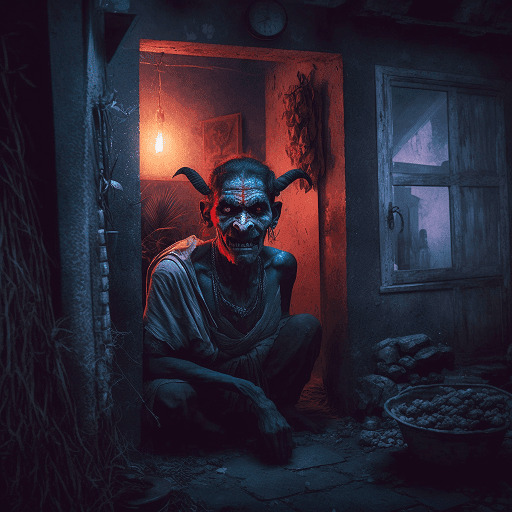
Pixaas is a bloodthirsty demon. It is a common motif in many mythologies and religions. A Pixaas, in many belief systems, is an evil spirit or supernatural entity that is often associated with chaos, destruction, and malevolence. The idea of a Pixaas refers to a demon that is said to crave or require blood for sustenance or as part of its destructive nature.
In some cultures, pixaas is believed to be supernatural entities that possess humans and cause them to commit heinous acts, including murder and mutilation. Some pixaas are also believed to feed on the blood or life force of living beings, often causing illness or death in their victims. The female counterpart of this creature is called Pixaasini, who are pretty similar to their male counterparts.
Kon bhoot

It is a 3 legged creature with no neck and an eye on his chest. This is regarded to be the king of the ghosts.
This is believed to have looked really scary and harmful in nature. This has the strength of mauling several human beings at the same time.
There are a lot more these are just a very few examples.
AI by Chinmoy Barma
@kathaniii
13 notes
·
View notes
Text
@kathaniii | Aloukik 2023 | Day X
Speaking of horror folklores no one forgets her
Via : BULBUL || 2020
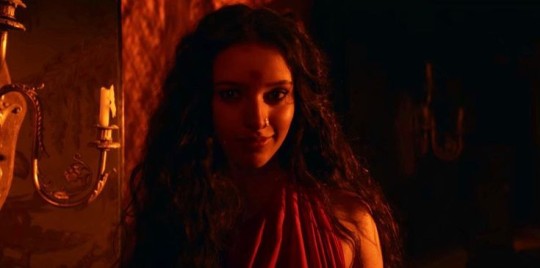


17 notes
·
View notes
Text
@kathaniii | Aloukik 2023 | Day X
And there's nothing like a mad woman, What a shame she went mad , No one likes a mad woman , You made her like that.
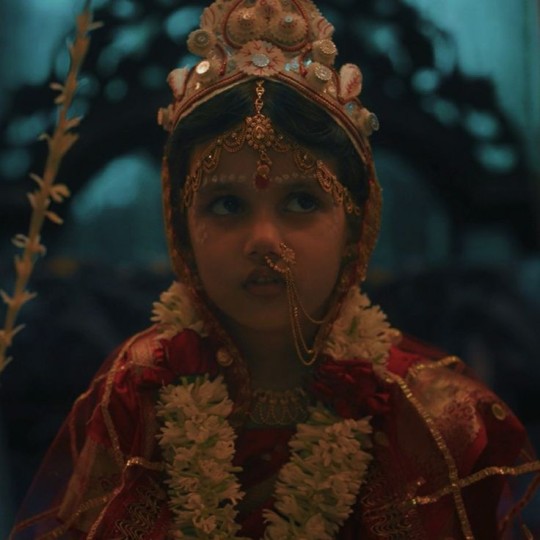
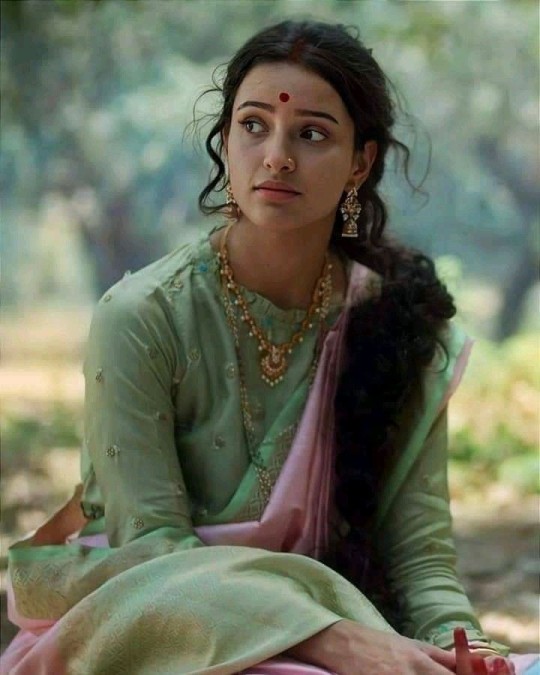
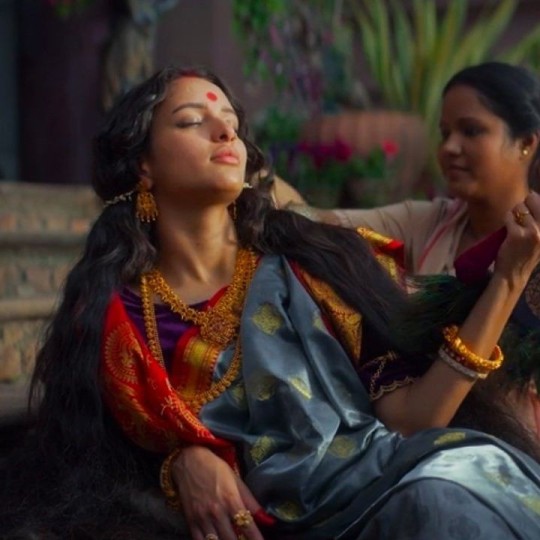

Never a demon , always a goddess .
31 notes
·
View notes
Text
@kathaniii | Aloukik 2023 | Day 2
ఌ︎𝐇𝐎𝐑𝐑𝐎𝐑 𝐅𝐎𝐋𝐊𝐋𝐎𝐑𝐄
🌹☾︎SHAKCHUNNI☽︎🌹


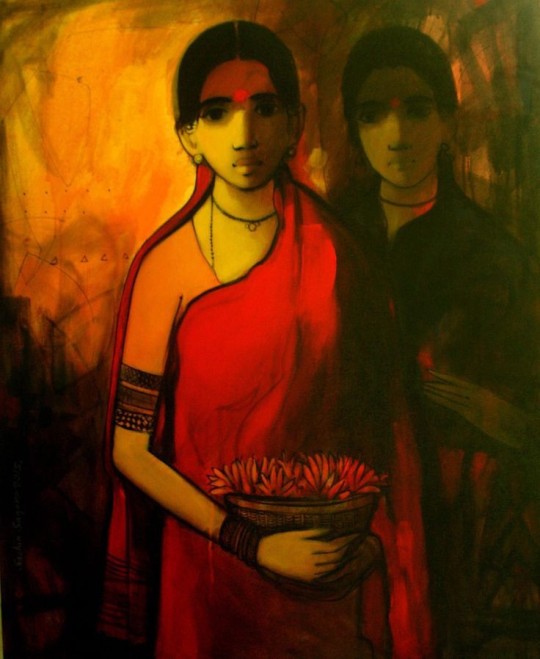

Shakchunni is a ghostly spirit, that's found often in Bengali culture and mythology , she stays in trees , loves fish and likes to trap men into adoring her , absolutely loves adorning Shakha Pola (bangles) and appears as a married women .
Here's a poem to her folklore ( written by me)
Grandma told us don't go into the depths
Of the forest not to the tree of the hanging roots
She lies there , in full brim
For all the ways that you so run into the forest
Never go close to the oldest tree
The tree of green and gold leaves
The tree of hanging like her hair
She lurks into the deep
And if you go near she might have you
And ask you to find her love
And for the love she may not find
She might make your living
Dreadful that you crave death
Grandma told us don't go into the depths
Of the forest not to the tree of the hanging roots
She lies there , in full brim
Leave the jewelleries you find in the forest
Sometimes offer fish
Stay away from her sight unless
you Wanna be friends ,
only you decide if it's worth it
Grandma said us don't go into the depths
Of the forest not to the tree of the hanging roots
She lies there , in full brim .

Thank you
54 notes
·
View notes
Text
Today we start Day 2, Horror. It's lowkey the prompt I'm most excited for. Can't wait to see what you come up with.

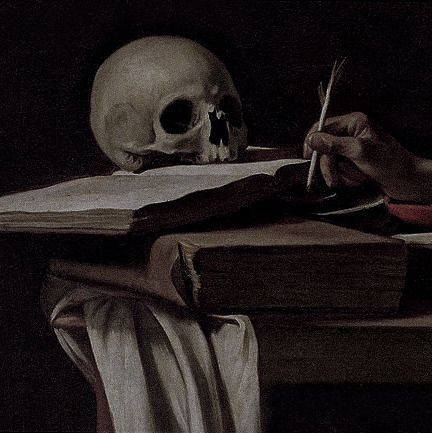
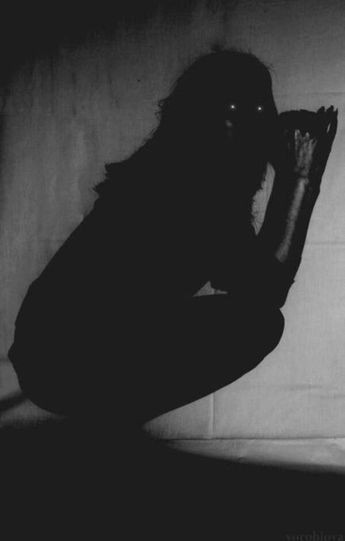
3 notes
·
View notes
Text
The Most Heartening Friends' Meet-up Ever
Kuchela alsoknown as Sudama is a childhood friend of Krishna. They were classmates at Sandipani Maharshi's ashramam. But upon reaching adulthood, Krishna became the ruler of Dvaraka, and Sudama remained an impoverished villager. His wife implored him to meet his old friend and request for some financial assistance.
He sets out to Dwaraka with a bundle of rice flakes. Krishna and Rukmini welcome him with so much love and treat him royally, which embarassed him. He doesn't mention anything about his situation or the gift of rice flakes. The poem mentioned in the post deals with their casual conversation.
But all knowing Krishna asks for rice flakes and Rukmini stops him from eating too much. Kuchelan returns to his home after some time, without asking for anything. But he is amazed when he reaches his village for his home have been conveyed to a palace with a lot of riches. He and his wife enjoy their newly found wealth and status with humility.
This Kathakali performance based on the story of Krishna and Kuchela is called "Kuchelavritham"
youtube
A shorter modern version (starts from 'Medura Bhakti Ulla')
youtube
Ajitha Hare Jaya Madhava Vishnu!
Unconquerable one! Hari! Jaya! Madhava! Vishnu!
Ajamukhadeva Nata!
He who is worshiped by other gods like Brahma
Vijaya Sarathe Sadhu Dwijan Onnu Parayunnu
Charioteer of Arjuna, this poor Brahmin is telling you
Sujana Sangamam Ettam Sukrithanivaha Sulabhamathanu Niyatham
Association with noble people is indeed meritorious and rare
Paladinamayi Njanum Balabhadranuja! Ninne
Nalamodu Kanmathinu Kaliyalle Ruchikkunnu.
Brother of Balarama, I have been yearning to visit you since a long time. I am not joking.
Kaalavishamam Kondu Kamam Sadichathilla
I was unable to fulfill my desire (to come and meet you) due to difficulties and obstacles
Neela Neeradavarna! Mridula Kamalaruchiranayana!Nrihare!
The one with the color of blue clouds! The one with eyes like soft lotus petals! The one had took the form of a lion!
Adyapi Bhawal Kripa Vidyothanamakum
Padyati Elkkuvathinu Bhagyam Undakuka Moolam
Now, since I am fortunate be enlightened by the earthen dust your grace,
Chaidyare! Janmaphalamee Dwijanenthu Venam?
Enemy of Chedi King, Sishupalan. What gift can this Brahmin desire more?
Hridhyam Tavaka Vrittam Mozhikilula Uraga Patium Adhuna
Your news is dearest to my heart. If those news are told, even Anantha will be swayed.
Medurabhaktiyulla Madrisham Sukhamanye
For the most devoted ones like me, there can be no other feeling than pleasure.
Vadamillaho Dukham Badhikkayilla Noonam
There is no arguing about it (no doubt). We won't be affected by sorrow
Yadavadhipia Ninne! Hridi Chinta Nidanena,
The leader of the Yadavas! If I perpetually think of you in my mind,
Modam me Valarunnu! Karuna Varanamarunasahaja Ketana!
My Happiness increases! Please have mercy, the one who has Aruna's brother (Garuda) the insignia!
I am from Kerala.
@kathaniii
18 notes
·
View notes
Text
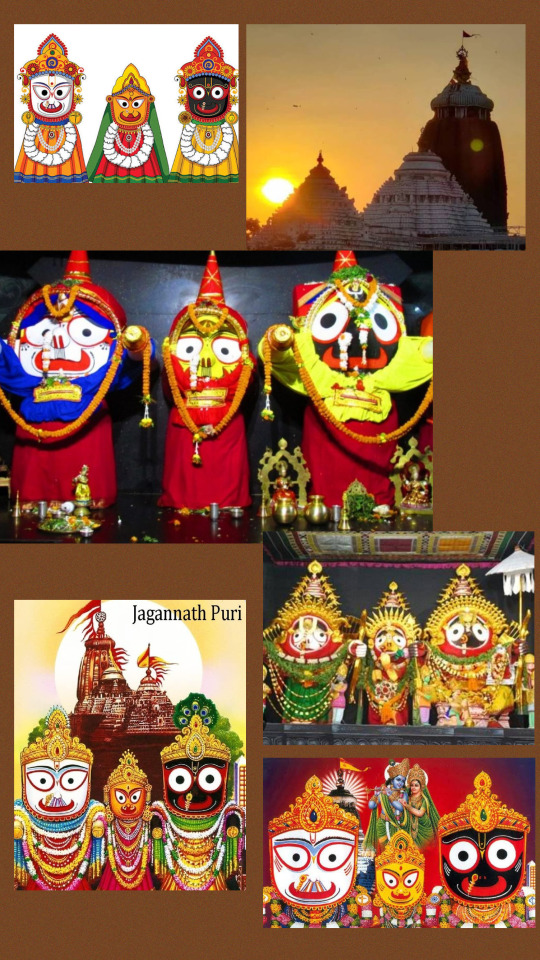
A tense feeling had engulfed the royal palace. Especially the Queen was agitated for some reason. She kept going near a locked door, put her ear on it to hear the sounds coming from inside. After listening for sometime, she would pace back and forth infront of the door. Then, she would again repeat the whole process.
This behavior of her would have continued if not for the King who came after being informed about the situation. When the King asked his wife about her strange behavior, instead of giving any reasons, she urged him to listen to the sounds inside the room himself.
The King, though perplexed by his beloved wife's actions, decided to humour her. After listening for few moments, he turned to the Queen.
"What did you hear?", asked the anxious Queen, even before the King could say anything.
"Nothing", replied the King. "What's the problem?"
"That's the whole problem!!!", exclaimed the Queen. "I have been coming here regularly since the old sculptor shut himself inside the room and listening to the sounds of carving of wood. But since today morning I haven't heard a peep out of the room. The old sculptor hasn't breathed his last, has he? He was looking so old and feeble when he went inside."
The King dismissed the Queen's concerns as overreaction and went on to carry out his duties.
But the Queen couldn't stop herself from worrying and would go to the locked door daily and listened in hope of catching any sound. But all she got was unnatural quietness instead. Even the King was disconcerted after few days. He couldn't even reassure himself, let alone his overwrought wife.
Finally, overcame by worry, the royal couple decided to open the locked door.
The King concurred with his wife's view that the old sculptor must had died inside the room as consequences of over exhaustion. But when he had the door opened, to his utter bewilderment, he found the room bereft of any person, living or dead. All he discovered inside the room was three unfinished idols, carved out of wood. The sculptor had vanished into thin air and further there was no signs of him ever being present there at all.
The King mentioned above was none other than the King Indradyumna, the legendary builder of the Lord Jagannath Temple at Puri.
After King Indradyumna found the log of Neem Wood (Daru), as per Lord Vishnu's instructions, he was baffled about how to carve the idol of Lord Vishnu out of it. Famous sculptors and artisans were summoned from every direction, only to fail at even putting a cut on the log of wood.
Finally, an old and feeble sculptor named Ananta Maharana, appeared infront of the King and offered to create the idol. He had only one condition, he would work in complete privacy inside a locked room and no one was allowed to disturb him during the entire process under any circumstances. The old King provided a room to the sculptor and locked it as per his condition, only to abruptly open it due to his Queen Gundicha's anxiousness.
After the carpenter vanished and incomplete idols were found, the King immediately repented. But Lord Vishnu himself instructed him to install the unfinished idols at the temple and assured him that he wished to grace his devotees in this form only.
This is the legend behind the unconventional idols at Lord Jagannath Temple of Puri. Some believed that the old sculptor was Vishwakarma, divine architect and sculptor and while others say he was none other than Lord himself, who came forth to create his own idol as per his whims. Hence, the idols are also called "self-made".
The idols with big eyes, square-shaped face and body without neck, ears and limbs, show the world that how perfectly delightful imperfection can be.
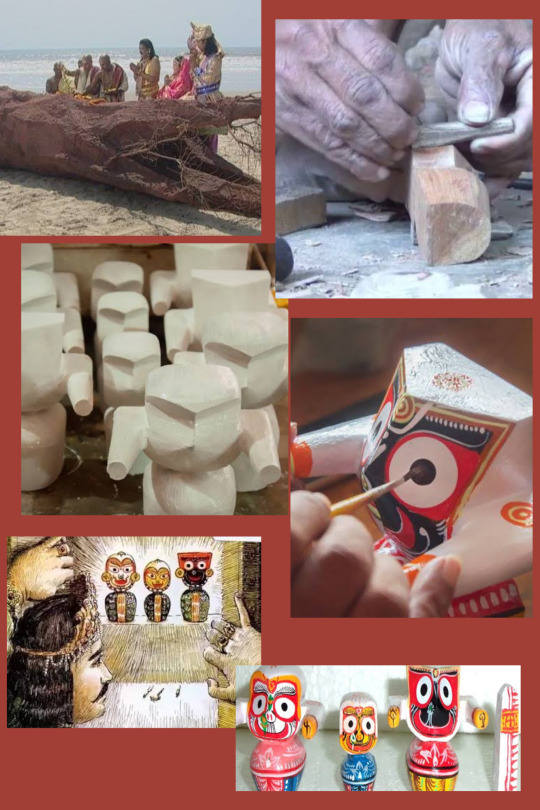
Jai Jagannath!!!
This is a story from Odisha.
@kathaniii | Aloukik 2023 | Day 1
12 notes
·
View notes
Text
We don't talk much about the time Dionysus came to India to convert the natives and introduce them to wine under the orders of his dad and Hera consequently going KillDio mode and wreaking chaos in the entirety of Olympus as well as the East.
33 notes
·
View notes
Text
Kalingattuparani
A parani is particular kind of Tamil literary composition which eulogises a warrior who has killed a thousand male elephants on the battle - field. A curious thing about this genre is that it is named after the vanquished foe.
Kalingattuparani is the most famous of all paranis. Composed by Jayamkondar, the poet laureate of Kulottunga Chola, it depicts the Chola invasion of Kalinga. It celebrates the triumph of Karunakara Tondaiman, the lord of Vandaiyar, a general of Kulottunga. Karunakara Tondaiman defeated the Kalinga king Anantavarman and planted a pillar of victory in Kalinga. However, we should remember that these are literary works produced under the patronage of rulers to appease them.
I would like to present a short extract from this great work used in the 2010 film Raavanan:
youtube
Let us begin the war
Let us begin the war
Soldiers on both camps shouted
War cries reverberated like the roar of the ocean! Charge the cavalry here!
Send the elephant division there!
These war cries went on increasing!
They stringed their strong bows
Rending all the directions by their noise!
In the battle-field
War cries struck the world dumb!
Both the armies dashed against each other
Like the confrontation of two oceans;
The charging of the cavalries
Like the confrontation of foaming waves!
Warring elephants dashed against each other
Like the clash of the mountains!
Chariots charged against each other
Like the clash of the clouds!
This is from Tamil Nadu
@kathaniii
26 notes
·
View notes
Text
The Harbour of Truth
In the port of Muscat, two sons were born to a rich merchant. As they grew up, their enemity too grew with them. He summoned the eldest of them and blessed him, "If you quarrel like this, one will murder the other. Therefore, you should not remain in the land of your father and forefathers. Go forth to the Harbour of Truth and prosper".
Therefore, the son was sent off with enough goods and ten special "containers of treasure". He traveled to many lands, met the chieftains, kings and emperors, and requested some of them to safekeep a 'treasure' till he returns. The treasure was a container of gold covered with a layer of pickle. But when he returned, all he got were containers filled with pickle.
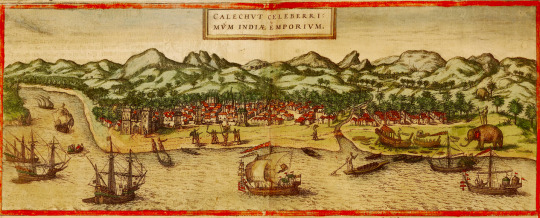
Finally, he reached Kozhikode, made the same request to the Zamorin (King of Kozhikode) and went to Lanka. When he returned, his container was returned to him. He noticed that the container hasn't gotten lighter nor the seal was broken. He realised that he finally discovered the Harbour of Truth.
He opened the container, presented the gold to the Zamorin and requested permission to settle down in Kozhikode. Thus, were established the Koyas of Kozhikode.
********
The name "Koya" comes from the Persian honourific "Khawaja" meaning "Master/Teacher". The chief of them was Shah Bandhar Koya, the Commissioner of the Kozhikode Port. He supervised customs on the behalf of the Zamorin, fixed the prices of the good, and collected the tax to the treasury. After Zamorin conquered Valluvakonathiri (King of Valluvanadu) and attained the Rakshapurusha Sthanam (the office of the Great Protector) of Mamankam, Shah Bandhar Koya was given the right to stand on the left side of the Zamorin during Mamankam.
I am from Kerala.
@kathaniii
13 notes
·
View notes
Text
First day of the #Aloukik event.
I'm from Assam, India so I'll be sharing some folktales and lores from my state.
But today I just wanna tell y'all the story of how we got the name of our state. Not the name Assam, but its original names- Kamarupa and Pragjyotishpura, the names that our state was referred to as in the epics of our country.
As for the first name, Kamarupa, this is what happened according to the scriptures-
The mythology regarding the origin of the name Kamarupa tells us the story of Sati who died due to the discourtesy shown to her husband by her father Daksha. Overcame by grief, Shiva carried her dead body and wandered throughout the world. In order to put a stop to this, Vishnu used his discus to cut the body into pieces, which then fell into different places. One such piece fell down on Nilachal hills near Gauhati and the place was henceforth held sacred as Kamakhya. But Shiva’s penance did not stop, so the Gods sent Kamdev, the cupid to break his penance by making him fall in love. Kamdev succeeded in his mission, but Siva enraged at this result, burnt Kamdev to ashes. Kamdev eventually regained his original form here and from then onward the country came to be known as Kamarupa (Where Kama regained his Rupa or form).
In case of the second name, Pragjyotishpura, this was the case.
Bhagadatta was the son of Narakasura, and he named his city Pragjyotishpura, where 'prag' means 'eastern', 'jyotish' means 'star' or 'astrology' and 'pura' means 'city'. So the meaning behind the name of this kingdom was the City of Eastern Star or City of Eastern Astrology.
In case of the modern name, Assam, formerly called Axom or Asom, the sources of its origin are vague so I'm not gonna talk about it.
Welp that's it for the first day I guess. A goof introductory history rant on how my state got its ancient names.
@kathaniii
25 notes
·
View notes
Text
Today is day 1 of the event. Can't wait to see your creations. Join and follow the blog for updates.

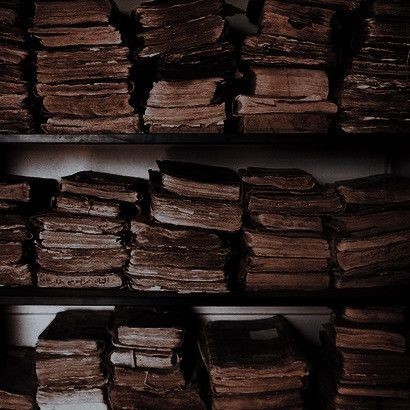

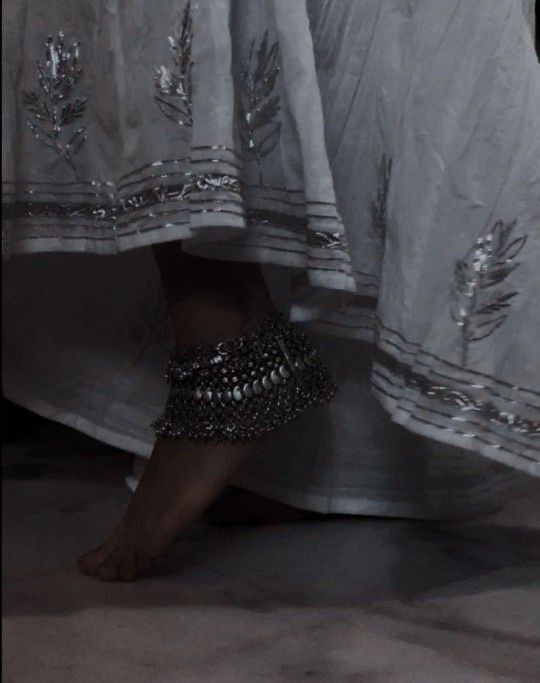

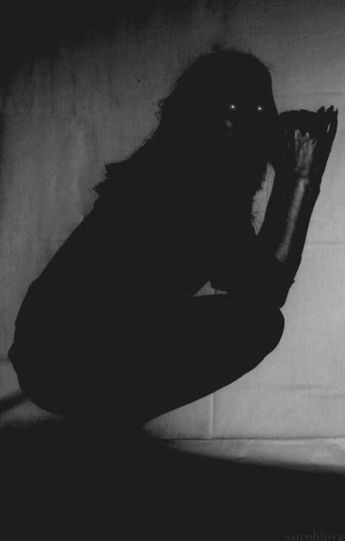

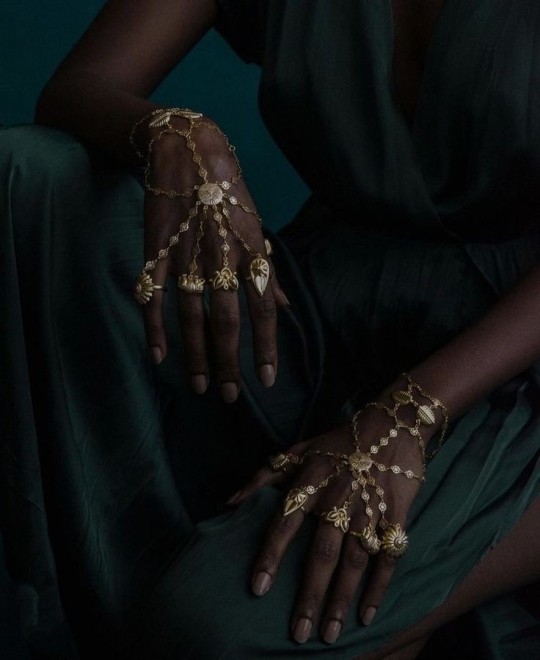

।। Aloukik।।
~ A folklore event ~
To all who are interested,
I'm hosting an event focusing on Indian folktales, fairytales, mythos and legend.
Aloukik is a month long event dedicated to highlighting stories from different cultures of India. There will be 10 prompts. It will run from 25th June to 24th July, with 3 days dedicated to each prompt.
Folklore has been an integral part of many cultures worldwide and India is no different. In our kaleidoscopic country, there exists a myriad of stories in different cultures, passed down from generation to generation. Storytelling has always been a fundamental part of human existence, stories become living, breathing things, transcending time and space as long there's someone to tell them.
So I'm inviting you to share your stories and your culture, folklore from any region, any state, any religion, any culture is welcome.
•To participate, you can post your writings, art, GIFs, Edits, Moodboards, anything you want.
•New content is appreciated but old content is also welcome.
•You can participate as much or as little as you'd like. You can post multiple entries for a given prompt or none at all.
•Late submissions are also welcome.
•Hateful content is not allowed. I have the right to ignore any content I see as hateful, but I will excercise this carefully. Furthermore, I will block you if it becomes a repeated offence throughout the event.
Be respectful of each other's cultures and religions.
To submit your entry, please follow the format given below:
@kathaniii | Aloukik 2023 | Day X
Please also use the event hashtag #Aloukik 2023.
The prompts are:
Day 1: (25th-27th June) Stories from your culture
Focus on and highlight stories from your state, religion or culture.
Day 2: (28th-30th June) Horror
Horror is a recurring theme in folklore. Horror stories are often the cornerstone of folktales. Highlight your favourite bhootnis, spirits, demons, and witches alike.
Day 3: (1st-3rd July) Women in Folklore
From witches to fairies, women have always played an integral role in many folktales and fairytales. Celebrate the inspiring women in folklore, their stories and their role in folk culture.
Day 4: (4th-6th July) Your Favourite Fairytales
Fairytales are, for most people, an important part of their childhood. Post about your favourite Princes and princesses, fairies and demons, kingdoms and magic.
Day 5: (7th-9th July) Unsung Stories
Post about folktales that you think are underrated and unsung. Tales that not many people know about, tales that you think deserve more love.
Day 6: (10th-12th July) Heroes and Heroines
Post about your favourite heroic characters, your favourite heroes and heroines, your favourite knights in shining armour.
Day 7: (13th-15th July) Villains
We all love a good villain and folktales have given us many iconic villains and antagonists. Post about your favourite evil queens, evil kings, dark witches and demon kings.
Day 8: (16th-18th July) Your favourite characters
Post about your favourite characters from fairytales and folktales. Tell us about any characters you fell in love with, hero or villain.
Day 9: (19th-21st July) Childhood stories
We all grew up hearing fairytales and folktales from our parents or grandparents. Tell us about your favourite childhood stories, stories you grew up with, stories you cherish.
Day 10: (22nd-24th July) Creator's Choice
This day is a free-for-all. Post about anything you want, any stories, any characters, anything your heart desires.
Feel free send any questions about the event to the event's blog @kathaniii. Thank you.
113 notes
·
View notes